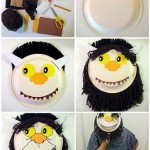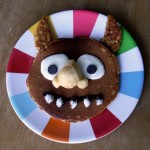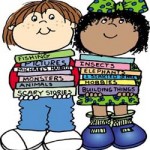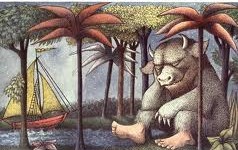Parents, Providers & Educators…….Join Self Help Inc. CFCE in celebrating Literacy Month!
The Staff at CFCE would like to invite you once again to participate in our annual Literacy Month Project. As you may know, the Governor issues a proclamation each fall designating November as Literacy Month and urges caring adults to spend time reading to children. The staff at Self Help Inc./CFCE has sponsored this project by offering parents and Early Childcare Providers literacy based activities and resources!
Check out our calendar of activities at http://selfhelpcpc.org/calendar/ to find special readings from area legislators!
We invite you to take part in this activity by reading “Where the Wild Things Are” and engage in the activities below. If you don’t already have this book at home, check your local library for availability! We hope you enjoy this project and also take a look at the resources for you to use at home or in the classroom with your child/ren. We ask providers to please forward this to any parents in your care.
If you participate, don’t forget to return the online questionnaire by December 12th to receive a free children’s book!
PARENT online questionnaire
PROVIDER online questionnaire
*PROVIDER’s must also submit a picture of their class reading or participating in an activity!
Where the Wild Things Are by Maurice Sendak

Summary: This is the story of Max, a little boy who takes an imaginary journey to a land of “Wild Things”. As Max’s imagination unfolds, his bedroom is transformed into an entirely new world. When he sails to the land of the Wild Things, they quickly make him their ruler. The Wild Things are tamed under Max’s fearless leadership and enjoy a “wild rumpus” planned by Max. Ultimately Max leaves the land of the Wild Things, despite their loving protests, to return home where he finds his dinner waiting for him.
Hints for Reading Aloud: This book lends itself to the use of dramatic verbal expression. As you read such lines as “They roared their terrible roars, and gnashed their terrible teeth”, use a dramatic voice. Your child will certainly be delighted to add a little drama as you read. Pause as you read the descriptions of the Wild Things and encourage your child to roar, show his/her claws, and gnash his/her teeth at the appropriate points. Help to develop your child’s vocabulary and comprehension by explaining new words (such as mischief, gnash, tame, and rumpus). After several readings, your child may take on the role of Max as you read: Pause and allow your child to fill in Max’s lines as you read.
Activities:

- Have a “wild rumpus” like Max and the Wild Things. You and your child can choose different movements to make (such as jumping, rolling, dancing, clapping, etc.). Then, let your child play the part of Max, who says in the story, “Now stop!” and the movement freezes. You can play this game repeatedly, allowing your child to suggest different movements and taking turns playing the role of Max. Look at the illustrations together to determine what types of movements the Wild Things used during their “rumpus”. This activity is even more fun if you add music: You can control the music, encouraging your child to dance while the music plays and “freeze” when he/she hears the music stop.
 Make a Wild Thing mask. You will need a paper plate, paper, scissors, glue, crayons and whatever collage materials you can find around the house, such as yarn and fabric scraps, buttons, cotton balls, glitter, sequins, pasta, tissue paper, wrapping paper, ribbon, etc. In advance, cut eye holes in the paper plate for your child. Then encourage your child to use the collage materials and his/her imagination to create a monster mask, the wilder, the better.
Make a Wild Thing mask. You will need a paper plate, paper, scissors, glue, crayons and whatever collage materials you can find around the house, such as yarn and fabric scraps, buttons, cotton balls, glitter, sequins, pasta, tissue paper, wrapping paper, ribbon, etc. In advance, cut eye holes in the paper plate for your child. Then encourage your child to use the collage materials and his/her imagination to create a monster mask, the wilder, the better. Cook up some “Wild Thing pancakes”. You will need pancake mix, food coloring, fruit pieces, and whipped topping. Have your child help you mix the pancake batter, adding food coloring along with the package ingredients. Talk about the package instructions, ingredients, and the preparation steps with your child as you mix the batter together. Cook the pancakes for your child. After the pancakes are cooked, help your child to decorate his/her pancake with the fruit pieces and whipped topping to create a “monster face”. ~ Taken from Parma City School District
Cook up some “Wild Thing pancakes”. You will need pancake mix, food coloring, fruit pieces, and whipped topping. Have your child help you mix the pancake batter, adding food coloring along with the package ingredients. Talk about the package instructions, ingredients, and the preparation steps with your child as you mix the batter together. Cook the pancakes for your child. After the pancakes are cooked, help your child to decorate his/her pancake with the fruit pieces and whipped topping to create a “monster face”. ~ Taken from Parma City School District
OTHER
- Math Match. Use this link CLICK HERE to print, cut and laminate cards and sails. Have the children identify the numeral on the sail. Then have them find the sail with the corresponding number of dots and put it on the boat.
- Please CLICK HERE for even more ideas and activities!
 If you want your child to be a reader, get him or her a library card.
If you want your child to be a reader, get him or her a library card. 
A library card equals reading independence! It’s empowering!
Tips:
- Your child will feel empowered by having their very own card and thus building the responsibility of caring for the books until they are returned.
- One backpack or reusable bag per child. Allow him to fill it up, choosing the books that interest him Believe me, they can’t wait to get home and get to read their NEW books!
- Facilitate good book choice. Suggest some books you think your child might enjoy or show her a new section – maybe the graphic novels, or the non-fiction craft section.
- Make the library visit as fun as possible. We like to eat cookies and read our books after a visit for extra library fun!
Check your local library for specific guidelines for children’s library cards. If your library has an age restriction for opening a card then make sure you have one for your child to use.
 Check out these literacy websites for kids and families:
Check out these literacy websites for kids and families:
- Wonderopolis
- Pbskids
- Literacycenter.net
- Seussville
- Reading RocketsCheck out these Websites for parents:
- Get Ready to Read
- Literacy Connections
- More Resources
 Funds for this program are provided through a grant from the MA Department of Early Education and Care’s Coordinated Family and Community Engagement Grant Program. For more information please call Michele Davidson at 508-559-1666 x128
Funds for this program are provided through a grant from the MA Department of Early Education and Care’s Coordinated Family and Community Engagement Grant Program. For more information please call Michele Davidson at 508-559-1666 x128






